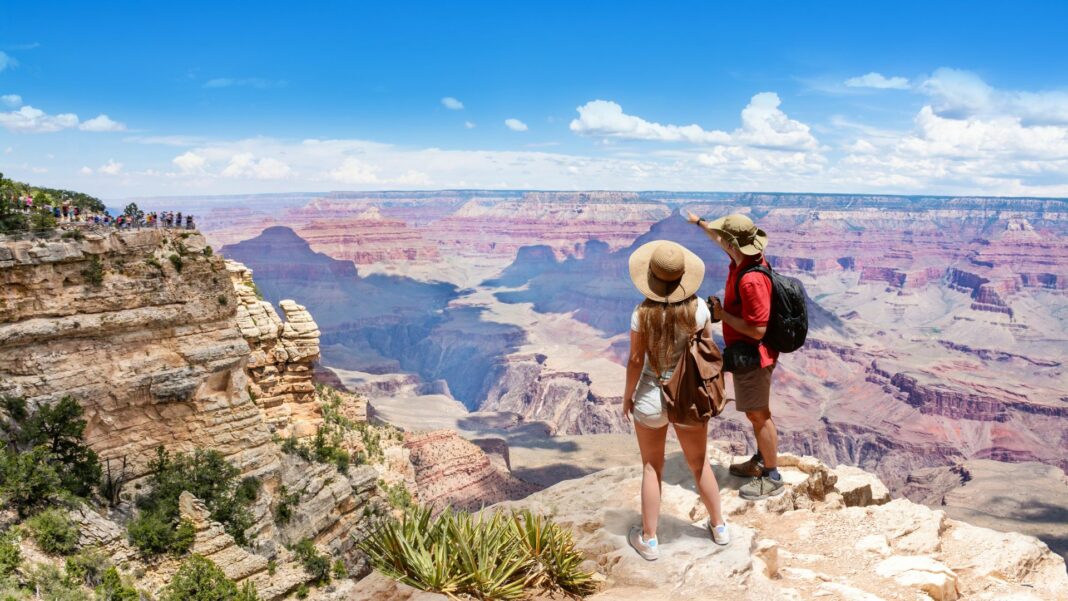
If you’re looking to explore the great outdoors, there’s no better place to start than by heading to one of America’s spectacular national parks. We analyzed the foot traffic recorded by the National Park Services to find out which National Parks had the most visits last year, as well as the year-over-year change in visits. With so much natural beauty across the United States, it can be challenging to decide where to visit. So, we’ve put together a list of the top 15 most-visited national parks in the U.S. where you can experience breathtaking landscapes, wildlife, and outdoor activities. Whether you’re planning a quick getaway or a short-term stay, consider visiting one of these top parks.
| 2022 Visits | National Park | 2022 Rank | 2021 Rank | Changes in Rank |
| 12,937,633 | Great Smoky Mountains National Park | 1 | 1 | No Change |
| 4,732,101 | Grand Canyon National Park | 2 | 4 | ↑2 |
| 4,692,417 | Zion National Park | 3 | 2 | ↓1 |
| 4,300,424 | Rocky Mountain National Park | 4 | 5 | ↑1 |
| 3,970,260 | Acadia National Park | 5 | 6 | ↑1 |
| 3,667,550 | Yosemite National Park | 6 | 8 | ↑2 |
| 3,290,242 | Yellowstone National Park | 7 | 3 | ↓4 |
| 3,058,294 | Joshua Tree National Park | 8 | 11 | ↑3 |
| 2,913,312 | Cuyahoga Valley National Park | 9 | 13 | ↑4 |
| 2,908,458 | Glacier National Park | 10 | 10 | No Change |
| 2,834,180 | Indiana Dunes National Park | 11 | 9 | ↓2 |
| 2,806,223 | Grand Teton National Park | 12 | 7 | ↓5 |
| 2,646,133 | Hot Springs National Park | 13 | 14 | ↑1 |
| 2,432,972 | Olympic National Park | 14 | 12 | ↓2 |
| 2,354,660 | Bryce Canyon National Park | 15 | 15 | No Change |
Methodology: The information in our table above represents the rankings of National Parks based on the number of visits they received in 2022, as reported by the National Park Services. Significant shifts in rankings between 2021 and 2022 include Grand Canyon National Park moving up two places into the second position with 4,732,101 visits. Also, Yellowstone National Park dropped four places to the seventh position with 3,290,242 visits. Other noteworthy shifts include Joshua Tree National Park and Cuyahoga Valley National Park, climbing three and four spots, respectively.
1. Great Smoky Mountains National Park
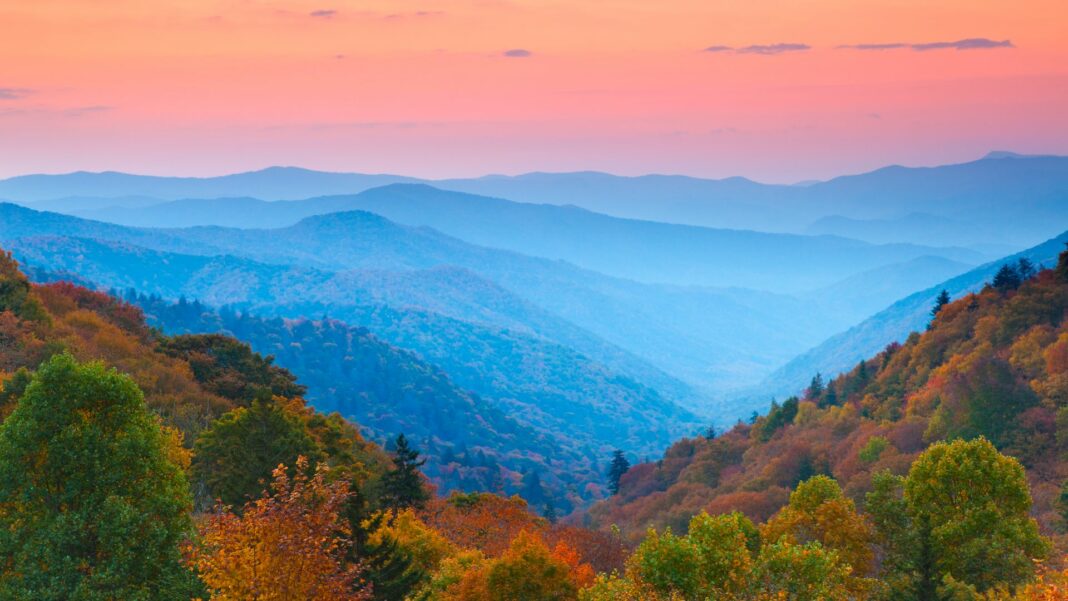
📆 When: The best time to visit the Great Smoky Mountains National Park is during the fall (mid-September to early November) to witness the vibrant autumn colors and in the spring (April to early June) when wildflowers are in bloom.
🌎 Where: The Great Smoky Mountains National Park is located in the eastern part of the United States, straddling the border between North Carolina and Tennessee.
🌤 Weather: The Great Smoky Mountains National Park experiences a moderate climate with mild winters, warm humid summers, cool and crisp fall weather, and a fairly wet environment throughout the year, though it can vary significantly due to the range of altitudes within the park.
📍Nearby towns: Gatlinburg, Tennessee, and Pigeon Forge, Tennessee
🎉 Things to do: In the Great Smoky Mountains National Park, visitors can enjoy hiking on over 800 miles of trails, wildlife viewing, scenic drives like the Cades Cove Loop Road, exploring historical structures, and camping under the stars.
🥇Best for:
- Appalachian culture enthusiasts: Visitors interested in the history and culture of the Appalachian people.
- Nature photographers: The park’s plant and animal life offers excellent opportunities for photography.
- Family vacationers: With many accessible trails and picnic areas, it’s an excellent destination for families.
Nestled between Tennessee and North Carolina, Great Smoky Mountains National Park attracts over 12 million visitors annually, making it the most visited national park in the country. The park’s landscape is characterized by picturesque waterfalls, lush forests, and the scenic Appalachian Trail. Known for its vibrant autumn colors and charming log cabins, it’s a popular year-round destination for hikers, campers, and outdoor enthusiasts.
As you explore the Great Smoky Mountains National Park, you’ll be treated to an array of breathtaking natural wonders. One of the most popular attractions in the park is Cades Cove, a lush valley surrounded by majestic mountains. Here, you can take a scenic drive or bike ride and spot wildlife such as black bears, white-tailed deer, and coyotes.
If you’re looking for a more challenging hike, consider trekking to the summit of Mount LeConte, the third-highest peak in the park. This strenuous 11-mile round-trip hike rewards you with stunning panoramic views of the surrounding landscape.
For those seeking a more leisurely outdoor experience, the park offers plenty of opportunities for fishing, picnicking, and simply taking in the stunning scenery. In the fall, the park’s vibrant foliage attracts photographers and nature enthusiasts from around the world.
Whether you’re a seasoned hiker or looking for a peaceful retreat in the heart of nature, the Great Smoky Mountains National Park is a must-visit destination in the USA. With its stunning natural beauty and endless recreational opportunities, it’s no wonder why this park is so beloved by visitors from all over the world.
2. Grand Canyon National Park
📆 When: The best time to visit Grand Canyon National Park is during the spring (April to June) and fall (September to November) when the weather is mild, and the park is less crowded.
🌎 Where: Grand Canyon National Park is located in the northwestern part of Arizona, in the southwestern United States.
🌤 Weather: The Grand Canyon National Park experiences extreme temperature variations throughout the year, with cold, snowy winters, particularly on the North Rim, and hot summers, especially in the Inner Canyon, while spring and fall tend to have milder and more comfortable weather.
📍Nearby towns: Flagstaff, Arizona, and Tusayan, Arizona
🎉 Things to do: In Grand Canyon National Park, visitors can enjoy hiking or mule riding into the canyon, river rafting in the Colorado River, scenic drives along the South Rim, watching sunrise or sunset, and stargazing due to the park’s International Dark Sky Park status.
🥇Best for:
- Adventure seekers: With opportunities for rafting, hiking, and mule trips, this park is a draw for those seeking an adrenaline rush.
- Geology lovers: The Grand Canyon showcases a geological timeline that interests many visitors.
- Romantic escape: These breathtaking views make this a popular destination for couples and honeymooners.
The Grand Canyon is located in Northwest Arizona. The grand Canyon National Park is an awe-inspiring natural wonder. With over 4.5 million visitors each year, the canyon offers visitors the opportunity to see one of the most stunning geological formations in the world. The Grand Canyon is a mile deep and 277 miles long, with a width that varies from 4 to 18 miles. The canyon was formed by the Colorado River over millions of years, and the layers of rock reveal a fascinating history of the Earth’s geology.
Visitors to the Grand Canyon can explore the park in many ways. The most popular way is to hike along the rim, which offers stunning views of the canyon. The South Rim is the most visited area of the park and is open year-round. The North Rim is less crowded and offers a more remote experience. Visitors can also take a mule ride down into the canyon, which is a unique and unforgettable experience.
For those seeking more adventure, the Grand Canyon offers a variety of activities such as white-water rafting, kayaking, and camping. The Colorado River runs through the canyon, providing a thrilling and unforgettable experience for those who choose to take on its rapids.
The Grand Canyon is also home to an array of wildlife, including bighorn sheep, coyotes, and elk. Visitors can take a guided tour with a park ranger to learn more about the park’s flora and fauna. The park also offers stargazing programs, where visitors can view the night sky and learn about the constellations.
Whether you’re a nature lover, adventure seeker, or simply looking for a peaceful retreat, the Grand Canyon National Park is a must-visit destination. Its stunning beauty and rich history are sure to leave a lasting impression on any visitor.
3. Zion National Park
📆 When: For optimal weather and fewer crowds, consider visiting Zion National Park during the months of April to June or September and October.
🌎 Where: Zion National Park is situated in the southwestern region of Utah, United States.
🌤 Weather: Zion National Park experiences a range of climates throughout the year, with hot, dry summers, mild to cool fall and spring seasons, and relatively cold winters with occasional snowfall.
📍Nearby towns: Springdale, Utah, and Hurricane, Utah
🎉 Things to do: At Zion National Park, visitors can immerse themselves in activities such as hiking through the dramatic landscape of The Narrows, exploring the Emerald Pools trails, ascending Angels Landing, taking scenic drives, and observing different wildlife.
🥇Best for:
- Backcountry campers: Zion’s wilderness provides ample opportunities for primitive camping experiences.
- Birdwatchers: Zion is home to various bird species, attracting bird enthusiasts.
- Solo trekkers: Its various trails make it an excellent park for a solo adventure.
Situated in southwestern Utah, Zion National Park beckons adventure-seekers with its extraordinary outdoor experiences. The park entices visitors to traverse its striking red rock canyons, delve into the intricate slot canyons, or embark on a picturesque journey along Zion Canyon Scenic Drive. With an annual influx of over 4 million visitors, it’s no surprise that Zion holds its place as one of Utah’s most renowned “mighty five” national parks.
A standout among Zion National Park’s hiking trails is Angels Landing. This demanding trek leads visitors along a steep and precarious path to the summit of a towering rock formation, rewarding their efforts with awe-inspiring views of the park’s expanse and the surrounding scenery.
For a more leisurely excursion, the Riverside Walk provides a wonderful alternative. This accessible, paved trail meanders beside the Virgin River, presenting visitors with a continuous panorama of the imposing canyon walls.
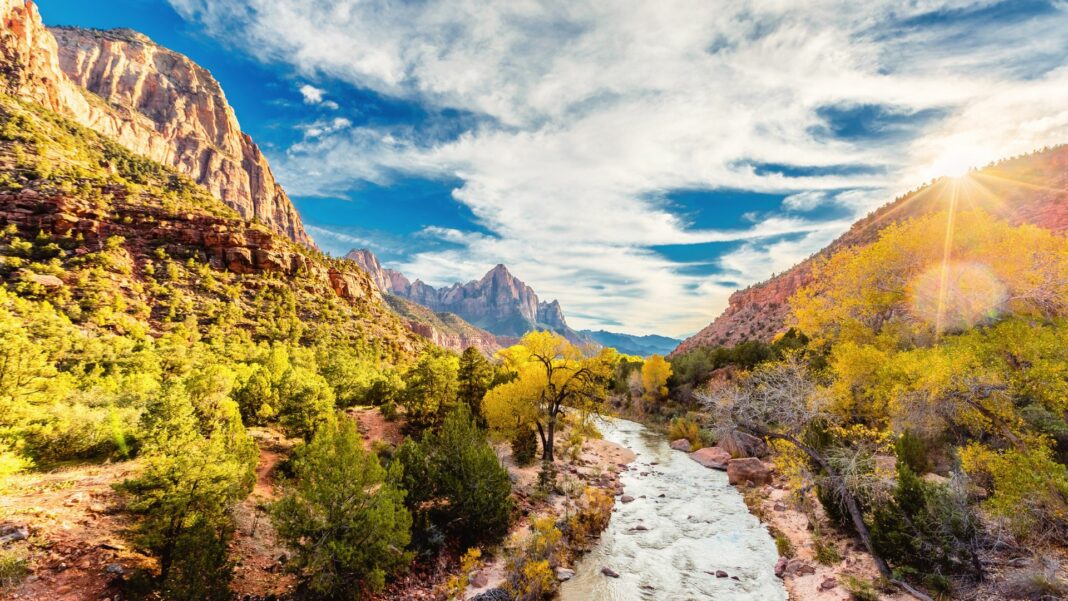
Zion National Park is a haven for wildlife, including bighorn sheep, mule deer, and golden eagles. Smaller creatures such as squirrels, chipmunks, and lizards can also be observed throughout the park.
In summary, Zion National Park offers an unparalleled and memorable outdoor adventure. With its breathtaking landscapes, exhilarating hikes, and abundant history, it is easy to understand why millions of visitors are drawn to this park each year.
4. Rocky Mountain National Park
📆 When: The best time to visit Rocky Mountain National Park is from June to September, when most park roads and trails are open.
🌎 Where: Rocky Mountain National Park is located in the north-central region of Colorado, United States.
🌤 Weather: The park experiences a range of weather throughout the year, with cold, snowy winters, mild to warm summers, and variable conditions in spring and fall, often influenced by elevation.
📍Nearby towns: Estes Park, Colorado, and Loveland, Colorado
🎉 Things to do: Activities to enjoy in Rocky Mountain National Park include hiking through its extensive trail system, wildlife viewing, scenic drives along Trail Ridge Road, camping, and stargazing.
🥇Best for:
- Mountaineers: A paradise for people who love high-altitude climbing and hiking.
- Wildlife observers: Known for its wide-range of wildlife, including elk and bighorn sheep.
- Winter sports enthusiasts: Cross-country skiing and snowshoeing are popular winter activities here.
The Rocky Mountains are an extensive mountain range that range from New Mexico to Canada. boast one of the most stunning natural landscapes in the country. Rocky Mountain National Park offers visitors an opportunity to experience this majestic range firsthand, with over 4 million people visiting each year. From hiking and camping to scenic drives, visitors can explore the rugged beauty of the park’s alpine environment.
The park is home to a range of wildlife, including elk, moose, bighorn sheep, and black bears. Visitors can often spot these animals grazing in the meadows or wandering through the forests. The park is also home to more than 350 miles of trails, ranging from easy strolls to challenging hikes up steep mountain peaks. Hikers can take in stunning views of the surrounding mountains and valleys, as well as the park’s many lakes and waterfalls.
For those who prefer a more leisurely visit, the park offers several scenic drives that wind through the mountains and offer breathtaking views at every turn. Visitors can also take advantage of the park’s many ranger-led activities, which include guided hikes, wildlife watching, and educational programs on the park’s history and ecology.
In addition to its natural wonders, Rocky Mountain National Park also has a rich cultural history. The park is home to several historic sites, including the Holzwarth Historic Site, which offers a glimpse into the lives of early settlers in the area. Visitors can also explore the park’s many museums and visitor centers, which provide information on the park’s geology, ecology, and history.
Whether you’re a seasoned outdoor enthusiast or just looking for a peaceful escape from the hustle and bustle of everyday life, Rocky Mountain National Park is a must-see destination. With its stunning natural beauty, wildlife, and rich cultural history, it offers something for everyone.
5. Acadia National Park
📆 When: The ideal time to visit Acadia National Park is during the fall (September and October) for foliage and summer (June to August) for warm weather activities.
🌎 Where: Acadia National Park is located on Mount Desert Island along the coast of Maine, United States.
🌤 Weather: Acadia National Park has a temperate coastal climate, with cold, snowy winters and warm, often humid summers, while spring and fall bring milder conditions with variable weather.
📍Nearby towns: Bar Harbor, Maine, and Ellsworth, Maine
🎉 Things to do: At Acadia National Park, visitors can enjoy hiking, biking on the historic carriage roads, exploring the scenic Park Loop Road, viewing wildlife, and witnessing the sunrise from Cadillac Mountain.
🥇Best for:
- Sea lovers: Being on the coast, this park attracts those who love the ocean, offering kayaking and tide pooling.
- Leaf peepers: The fall foliage in Acadia is a major draw for visitors.
- Stargazers: The park’s annual Night Sky Festival is a highlight for astronomy enthusiasts.
If you’re looking for a national park experience on the East Coast, Acadia National Park, located in Maine, is your best bet. Home to the tallest mountain on the Atlantic Coast, Acadia National Park offers visitors a mix of forested areas, rocky coastlines, and freshwater lakes. It’s a popular destination for hiking and cycling, with over 3 million visitors annually.
Acadia National Park is a true gem of the East Coast, offering a unique and diverse landscape that is not found anywhere else. The park is spread over an area of 47,000 acres and is home to a variety of wildlife, including black bears, moose, and bald eagles. The park’s highest peak, Cadillac Mountain, offers stunning views of the surrounding landscape and is a must-visit spot for any visitor to the park.
One of the most popular activities in Acadia National Park is hiking. The park has over 120 miles of hiking trails, ranging from easy walks to challenging climbs. Some of the most popular trails include the Jordan Pond Path, the Precipice Trail, and the Beehive Trail. These trails offer stunning views of the park’s lakes, mountains, and coastline, and are a great way to explore the park’s natural beauty.
If you’re not up for hiking, there are plenty of other activities to enjoy in Acadia National Park. The park’s lakes and coastline offer great opportunities for swimming, kayaking, and fishing. The park also has a number of campgrounds, making it an excellent destination for a weekend camping trip.
Acadia National Park is also home to several historic sites, including the Bass Harbor Head Lighthouse and the Jordan Pond House. These sites offer a glimpse into the park’s rich history and are a great way to learn more about the area.
Overall, Acadia National Park is a must-visit destination for anyone looking to experience the natural beauty of the East Coast. Acadia National Park is truly a national treasure with its landscape, abundant wildlife, and endless outdoor adventure opportunities.
6. Yosemite National Park
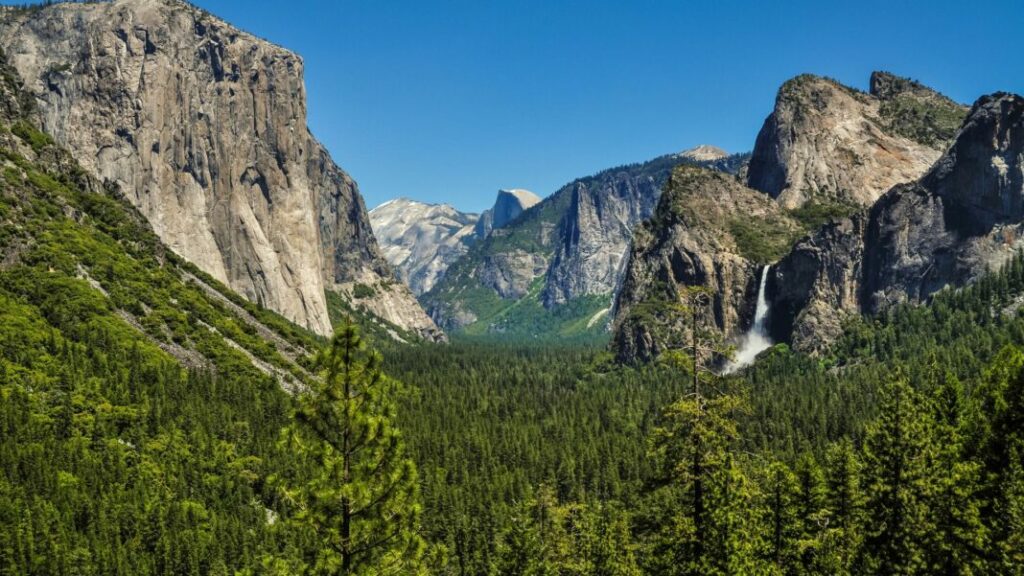
📆 When: Yosemite National Park is most comfortably visited during the late spring and early summer months, from May to June, when the park’s famous waterfalls are at their peak.
🌎 Where: Yosemite National Park is situated in the Sierra Nevada mountains in central California, United States.
🌤 Weather: Throughout the year, Yosemite National Park experiences weather variations, with cold, potentially snowy winters, hot summers, and mild conditions in spring and fall.
📍Nearby towns: Mariposa, California, and Sonora, California
🎉 Things to do: In Yosemite National Park, popular activities include hiking to landmarks like Half Dome and El Capitan, viewing waterfalls, wildlife watching, stargazing, and winter sports such as skiing and snowshoeing.
🥇Best for:
- Rock climbers: Yosemite’s El Capitan and Half Dome are iconic climbing destinations.
- Waterfall chasers: Home to numerous waterfalls, it’s a great destination for those who love these natural wonders.
- Artists: The park’s scenic beauty has inspired artists for generations.
A place for outdoor adventures and beauty, Yosemite National Park is a crown jewel of the nation’s park system. This national park brings over 3.5 million visitors every year. Renowned for its spectacular granite cliffs, clear streams, towering waterfalls, and giant sequoia groves, Yosemite offers a taste of untouched wilderness and serene tranquility.
The park is a paradise for wildlife enthusiasts, hosting an array of species such as mule deer, black bears, and a variety of bird species. Visitors may often find these creatures basking in the sunlit meadows or sauntering through dense forests. The park also boasts over 800 miles of trails, providing options for gentle ambles or more strenuous treks leading to mesmerizing vistas of the valley, waterfalls, and alpine peaks.
For those favoring a more laid-back journey, the park provides several picturesque drives that meander through the majestic landscape, presenting awe-inspiring panoramas at every twist and turn.
Beyond its natural splendors, Yosemite National Park is steeped in cultural heritage. The park houses several historic sites, including the iconic Ahwahnee Hotel, a National Historic Landmark. Visitors can also delve into the park’s rich past and intriguing geology at the numerous museums and visitor centers scattered across the park.
Whether you’re an avid adventurer seeking exhilarating outdoor activities or someone seeking a serene retreat into nature’s lap, Yosemite National Park is an unmissable destination. With its awe-inspiring landscapes, abundant wildlife, and fascinating cultural heritage, it offers an enriching experience for all.
7. Yellowstone National Park
📆 When: The optimal time to visit Yellowstone National Park is during late spring and early fall, from May to June and September to November when the weather is pleasant and the park is less crowded.
🌎 Where: Yellowstone National Park is primarily located in the U.S. state of Wyoming, extending into Montana and Idaho.
🌤 Weather: The weather at Yellowstone National Park varies significantly throughout the year, with cold, often snowy winters, mild to warm summers, and cooler temperatures in the spring and fall.
📍Nearby towns: Jackson, Wyoming and Bozeman, Montana
🎉 Things to do: In Yellowstone National Park, visitors can marvel at the iconic Old Faithful geyser, explore the Grand Canyon of Yellowstone, view abundant wildlife, hike numerous trails, and visit the Mammoth Hot Springs.
🥇Best for:
- Geothermal features aficionados: The park’s geysers and hot springs attract many visitors.
- Wildlife watchers: Known for its large mammals, including bears, wolves, and herds of bison and elk.
- Family explorers: With its educational ranger programs and various geologic and wildlife features, it’s a hit with families.
Yellowstone National Park, sprawled across the states of Wyoming, Montana, and Idaho, is an iconic symbol of America’s wild and untamed beauty, attracting over 3.2 million visitors annually. Celebrated as the world’s first national park, Yellowstone is a captivating mosaic of geysers, hot springs, verdant forests, and rugged canyons.
The park is a haven for a myriad of wildlife, including grizzly bears, wolves, and herds of bison and elk, often spotted roaming freely across expansive landscapes. Yellowstone is also home to more than 900 miles of trails, catering to casual strollers and avid hikers alike, leading them through towering peaks, deep valleys, and alongside the park’s many lakes and rivers.
For those who desire a more leisurely exploration, the park provides an array of scenic drives that wind through Yellowstone’s diverse terrains, offering magnificent views at every bend. The park’s ranger-led activities are equally engaging, encompassing guided walks, wildlife spotting, and intriguing presentations on the park’s geothermal features and history.
In addition to its natural wonders, Yellowstone National Park carries a significant cultural legacy. The park harbors several historic landmarks, including the illustrious Old Faithful Inn and Roosevelt Arch. Visitors can also dive into the park’s rich past and unique geology at the various museums and visitor centers scattered throughout the area.
Whether you’re an adventure enthusiast pursuing thrilling outdoor exploits or a peace-seeker yearning for a calm retreat amidst nature, Yellowstone National Park is an essential addition to your travel list. Its geothermal marvels, abundant wildlife, and compelling cultural history promise a uniquely enriching experience for all visitors.
8. Joshua Tree National Park
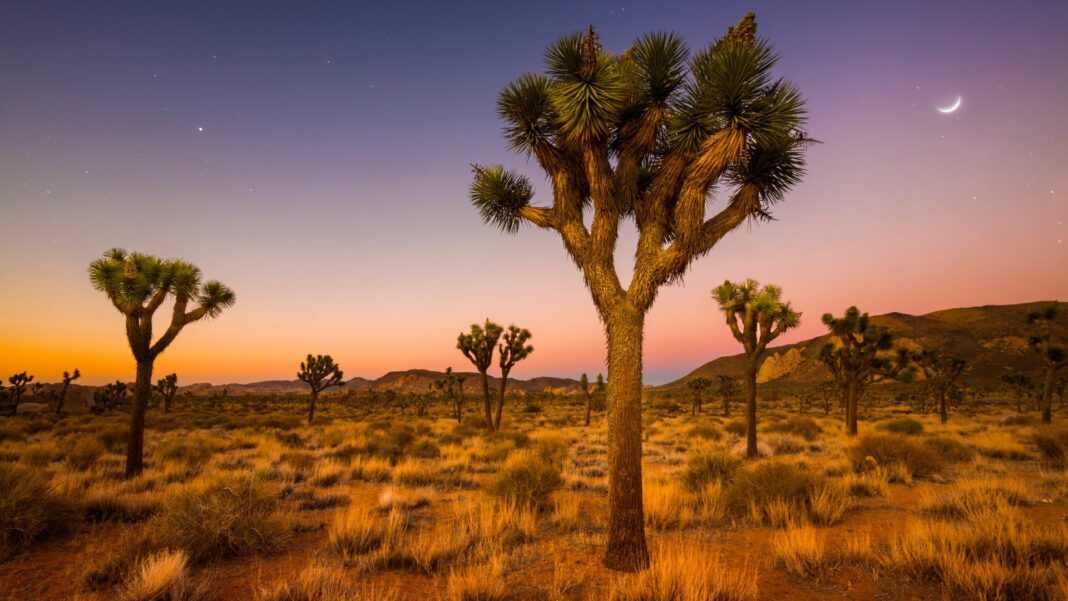
📆 When: To avoid the extreme heat of summer, the best time to visit Joshua Tree National Park is during the cooler months of February to April and October to November.
🌎 Where: Joshua Tree National Park is located in southeastern California, straddling the Mojave and Colorado deserts.
🌤 Weather: The park experiences a desert climate with scorching summers, mild winters, and moderate temperatures in the spring and fall, with little annual rainfall.
📍Nearby towns: Twentynine Palms, California, and Yucca Valley, California
🎉 Things to do: Joshua Tree National Park offers activities such as hiking, sound baths, rock climbing, camping under the stars, exploring desert trails, and viewing the park’s iconic Joshua Trees and wildlife.
🥇Best for:
- Desert adventurers: Perfect for those who appreciate the stark beauty of desert landscapes.
- Rock climbers and bouldering enthusiasts: The park’s unique rock formations provide plenty of climbing opportunities.
- Night sky viewers: Its remote location makes it a great spot for stargazing.
Joshua Tree National Park, located in Southern California, is a mesmerizing fusion of two distinct desert ecosystems: the Mojave and the Colorado. Drawing over 3 million visitors annually, this park is a unique spectacle of stark desert landscapes, studded with its namesake Joshua Trees and dramatic rock formations.
The park serves as a sanctuary for diverse wildlife, including desert bighorn sheep, coyotes, and numerous bird species. Visitors often enjoy observing these animals in their natural habitats, amidst the vast expanses of desert and under the wide-open skies. With over 300 miles of trails, Joshua Tree caters to hikers of all levels, offering paths that range from leisurely walks through cactus gardens to challenging climbs up rugged mountain trails.
For those preferring a more laid-back exploration, the park provides several scenic drives that crisscross the desert landscapes, showcasing breathtaking panoramas and dramatic sunsets. Joshua Tree is also famous for guided walks, evening programs at the amphitheater, and stargazing sessions – the park is renowned for its exceptionally dark, clear night skies.
Beyond its natural allure, Joshua Tree National Park has a rich cultural heritage. The park features several historical sites, including old mines and ranches that bear testimony to the area’s mining and cattle-ranching history. Visitors can learn more about the park’s ecology, geology, and cultural history at the various visitor centers.
Whether you’re an intrepid explorer seeking exhilarating hiking experiences, a nature lover looking for wildlife encounters, or a stargazer captivated by the cosmos, Joshua Tree National Park is an unforgettable destination. Its distinct desert beauty, varied wildlife, and intriguing cultural past offer a unique and enriching experience for every visitor.
9. Cuyahoga Valley National Park
📆 When: Cuyahoga Valley National Park is best visited during the fall months (September and October) to see the vibrant fall colors and spring (April and May) for wildflower blooms.
🌎 Where: Cuyahoga Valley National Park is between Cleveland and Akron in northeastern Ohio.
🌤 Weather: The park experiences a temperate climate with hot, humid summers and cold, snowy winters; spring and fall are generally mild but unpredictable.
📍Nearby towns: Akron, Ohio, and Cleveland, Ohio
🎉 Things to do: At Cuyahoga Valley National Park, visitors can enjoy hiking and biking along the Towpath Trail, exploring the Brandywine Falls, taking scenic train rides on the Cuyahoga Valley Scenic Railroad, and birdwatching.
🥇Best for:
- Historical enthusiasts: Individuals who are drawn to historical sites will find the park’s historic buildings and the Ohio and Erie Canal Towpath Trail fascinating.
- Concert-goers: With a summer concert series hosted at the open-air venue of Howe Meadow, the park attracts music fans.
- Cycling fans: The park boasts an extensive biking trail system featuring the Towpath Trail, making it a must-visit for cycling enthusiasts.
Cuyahoga Valley National Park, nestled in the heart of Northeast Ohio, is a lush green retreat amidst the urban sprawl, attracting nearly 3 million visitors annually. With its rolling hills, vibrant forests, and serene waterways, the park presents a refreshing contrast to the neighboring cityscapes of Cleveland and Akron.
The park is a thriving habitat for a wide variety of wildlife, including white-tailed deer, beavers, and over 200 species of birds. Visitors frequently spot these creatures nestled in the woods or along the banks of the Cuyahoga River. Cuyahoga Valley boasts over 125 miles of trails, with routes ranging from tranquil towpath walks along the historic Ohio and Erie Canal to more challenging treks through dense forests and across rugged hills.
For those seeking a more leisurely exploration, the park offers a unique experience in the form of the Cuyahoga Valley Scenic Railroad, which provides an enchanting journey through the park’s landscapes.
In addition to its natural charm, Cuyahoga Valley National Park has a rich historical heritage. The park features several historic landmarks, including the Everett Covered Bridge and the Canal Exploration Center, which provides insight into the area’s canal-era past. Visitors can delve deeper into the park’s history, ecology, and geology at the various visitor centers scattered throughout the area.
Whether you’re an adventurous hiker searching for scenic trails, a nature enthusiast seeking wildlife sightings, or a history buff intrigued by the region’s past, Cuyahoga Valley National Park is a must-visit destination. Its lush landscapes, abundant wildlife, and fascinating cultural heritage provide an enriching and refreshing experience for all.
10. Glacier National Park
📆 When: The most suitable time to visit Glacier National Park is during the summer, from July to early September, when all facilities, roads, and trails are typically open.
🌎 Where: Glacier National Park is located in the U.S. state of Montana, bordering the Canadian provinces of Alberta and British Columbia.
🌤 Weather: Glacier National Park experiences a range of weather, with long, cold, snowy winters and short, cool to warm summers; conditions can change quickly, particularly at higher elevations.
📍Nearby towns: Whitefish, Montana, and Columbia Falls, Montana
🎉 Things to do: Popular activities in Glacier National Park include driving the Going-to-the-Sun Road, hiking its extensive trail system, wildlife viewing, camping, and boating on one of the many lakes.
🥇Best for:
- Glacier geology enthusiasts: The park offers a chance to see and learn about glaciers and their impact on the landscape.
- Wildlife watchers: The park is home to a variety of animals, including grizzly bears, mountain goats, and moose.
- Cross-country skiers and snowshoers: In the winter, the park offers excellent opportunities for these winter sports.
Glacier National Park, located in the verdant state of Montana, is a beautiful testament to the raw beauty of Mother Nature, attracting nearly 3 million visitors each year. The park offers a magnificent display of pristine wilderness with its glistening glaciers, azure lakes, and towering mountain peaks.
The park is a thriving refuge for an array of wildlife, including grizzly bears, moose, and mountain goats, often spotted against the backdrop of the park’s spectacular vistas. Glacier National Park also boasts over 700 miles of trails, offering opportunities for gentle lakeside strolls, challenging mountainous treks, and everything in between, with breathtaking panoramic views at every turn.
For those who favor a more relaxed exploration, the park’s iconic Going-to-the-Sun Road provides a scenic drive like no other, winding through its heart and offering striking views of its diverse landscapes.
Beyond its natural wonders, Glacier National Park holds a significant cultural legacy. The park is home to several historic lodges and chalets that hark back to the early days of national park tourism. Visitors can also delve into the park’s rich history and unique geology at the various visitor centers and museums scattered throughout the area.
Whether you’re a seasoned outdoor adventurer searching for challenging hikes, a wildlife lover looking for unique fauna, or a history enthusiast keen to delve into the region’s past, Glacier National Park is a destination that should not be overlooked. With its awe-inspiring landscapes, wildlife, and intriguing cultural history, it promises an unforgettable and enriching experience for all visitors.
Final thoughts
From the majestic peaks of Yosemite to the desert cliffs of the Grand Canyon, each national park offers a unique and awe-inspiring experience. So, pack your bags, embrace the spirit of exploration, and embark on a journey to discover the unparalleled beauty and untamed wilderness of America’s top national parks. If you’re looking for a quick visit, a short stay, or to plant your roots near the best outdoor recreation, each of these destinations aim to please.



